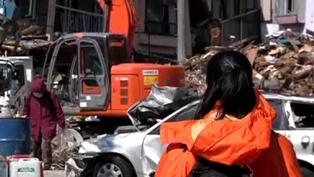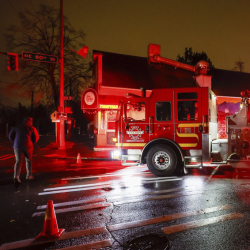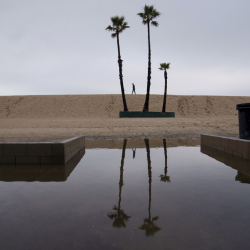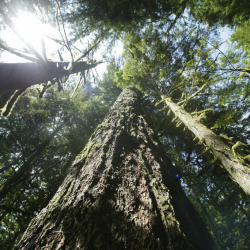 SENDAI, Japan (AP) -- Japanese and U.S. military ships and helicopters trolled Japan's tsunami-ravaged coastline looking for bodies Friday, part of an all-out search that could be the last chance to find those swept out to sea nearly three weeks ago.
SENDAI, Japan (AP) -- Japanese and U.S. military ships and helicopters trolled Japan's tsunami-ravaged coastline looking for bodies Friday, part of an all-out search that could be the last chance to find those swept out to sea nearly three weeks ago.
The Skanner News Video here
More than 16,000 are still missing after the disaster, which officials fear may have killed some 25,000 people. The 9.0-earthquake and tsunami also ravaged a nuclear plant that continues to leak radiation despite frantic efforts to control it.
Japan's prime minister sounded a resolute note Friday, promising to win the battle against the overheating plant even as atomic safety officials raised questions about the accuracy of radiation measurements there. Residents have been evacuated from around the plant.
On the outskirts of Sendai, near the Japanese military's Kasuminome air base, a constant stream of helicopters roared overhead throughout the afternoon, shuttling to and from the more remote coastal regions. Planes and boats were dispatched from other bases near the city.
Altogether, 25,000 soldiers, 120 helicopters, and 65 ships will continue searching through Sunday. If U.S. forces spot bodies, they will point them out to the Japanese military rather than trying to retrieve them. So far, more than 11,700 deaths have been confirmed.
"Unfortunately we've come across remains over the scope of our mission, so it may be more likely than you think," to find bodies at sea so long after the disaster, said U.S. Navy Lt. Anthony Falvo.
Some may have sunk and just now be resurfacing. Others may never be found. After the 2004 Indian Ocean tsunami, 37,000 of the 164,000 people who died in Indonesia simply disappeared, their bodies presumably washed out to sea.
The Japanese military stopped short of saying the search would end for good after Sunday, but public affairs official Yoshiyuki Kotake said activities will be limited. The search includes places that were submerged or remain underwater, along with the mouths of major rivers and the ocean as far as 12 miles (20 kilometers) from shore.
Police officers have also been searching for bodies in decimated towns inland, but in some cases their efforts have been complicated or even stymied by dangerous levels of radiation from the Fukushima Dai-ichi nuclear plant 140 miles (220 kilometers) northeast of Tokyo.
People who live within 12 miles (20 kilometers) have been forced to leave, though residents are growing increasingly frustrated and have been sneaking back to check on their homes. Government officials warned Friday that there are no plans to lift the evacuation order anytime soon.
"I don't think the evacuation zones make any sense," said Tadayuki Matsumoto, a 46-year-old construction worker who lives in a zone 15 miles (25 kilometers) away where residents have been advised to stay indoors. "They don't seem to have thought it out and are making things up as they go along."
Radiation concerns have rattled the Japanese public, already struggling to return to normal life after the earthquake-borne tsunami pulverized hundreds of miles (kilometers) of the northeastern coast. Three weeks after the disaster in one of the most connected countries in the world, 260,000 households still do not have running water and 170,000 do not have electricity.
Japan's nuclear safety agency on Friday ordered plant operator Tokyo Electric Power Co. to review its latest measurements of radiation in air, seawater and groundwater samples, saying they seemed suspiciously high.
TEPCO has repeatedly made mistakes in analyzing radiation levels, and the Nuclear and Industrial Safety Agency said it might eventually order a complete review of all radiation data collected since the tsunami.
Though the size of recent leaks is unclear, it appears radiation is still streaming out of the plant, underscoring TEPCO's inability to get it under control.
The company has increasingly asked for international help, most recently ordering giant pumps from the U.S. that will arrive later this month to spray water on the reactors.
The prime minister said in a televised news conference Friday that Japan will do whatever it takes to win the battle at Fukushima Dai-ichi, though he warned that it could be a long process.
"I promise to overcome this problem and regain a society where we can live with peace of mind," said Kan, who wore a suit instead of a blue work jacket for the first time since the tsunami. He also looked ahead, saying he wants to do something innovative beyond just restoring the areas that were destroyed.
He vowed that Japan would create the safest nuclear systems anywhere and reiterated that TEPCO will be responsible for compensating victims of the nuclear disaster - a bill that could be anywhere between 1 trillion and 10 trillion yen ($12 billion and $120 billion), depending on how long it takes to resolve the crisis, according to Yusuke Ueda, a Merrill Lynch analyst. Kan said the government will provide some compensation beyond the utility's legal responsibility.
Some cities are already helping their own residents. In hard-hit Natori, next to Sendai, dozens lined up to apply for funds as aircraft searching for bodies zoomed overhead.
Many people lost all of their possessions, including IDs, so the city has created software that compares neighborhoods before and after the tsunami. People point out where they lived, and if the house in that location has been destroyed, they are eligible for 100,000 yen ($1,200) in assistance.
"We have records of everyone that lived there, and so we can confirm identities by asking birthdays and other information," said Takeshi Shibuya, an official at city hall.
Some applying for the funds, like 33-year-old Osamu Sato, said it would be hardly be enough. He and his pregnant wife bought their apartment and moved in six months before the tsunami destroyed it, plus all of their new furniture and electronics.
"To be honest, 100,000 yen doesn't help much," Sato said. "I've lost everything."
---
Associated Press Writers Eric Talmadge in Fukushima and Ryan Nakashima, Shino Yuasa, Mayumi Saito, Noriko Kitano and Cara Rubinsky in Tokyo contributed to this report.
Portland and Seattle
Free Subscription to Breaking News
Free Subscription to Breaking News




















































































































































































































































































































































